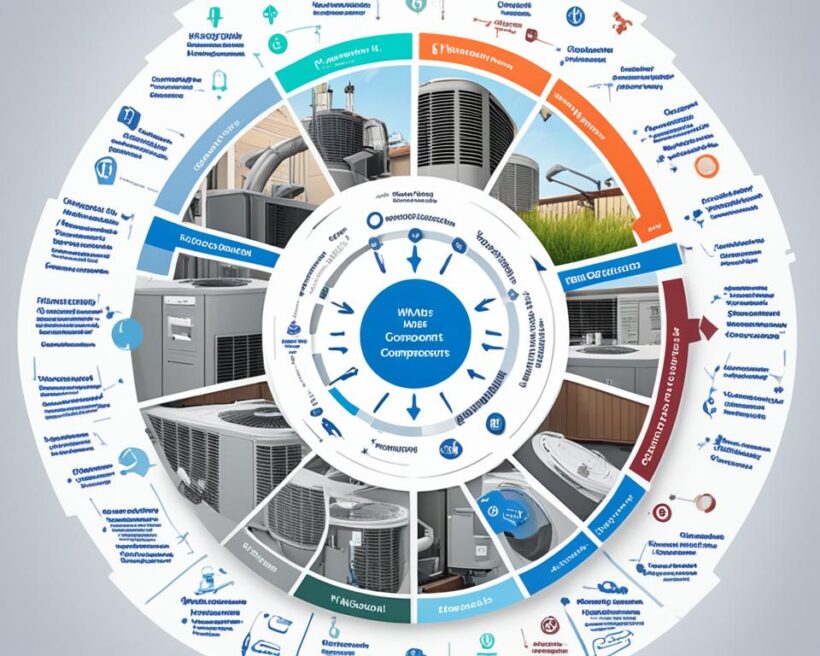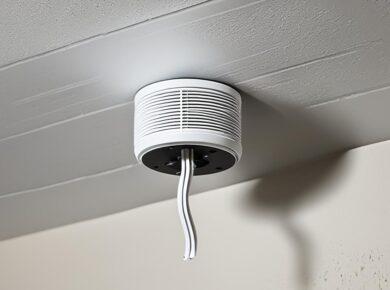Did you know that HVAC systems are responsible for 50% of a typical household’s energy consumption? That’s right, heating, ventilation, and air conditioning systems have a significant impact on your energy bills and overall comfort. It’s crucial to understand the various components of an HVAC system to ensure efficient operation and identify any potential issues. In this article, I will introduce you to 15 essential HVAC system components that you should know about.
But before we dive into the details, let’s take a moment to appreciate the scale of the impact HVAC systems have on our daily lives. From heating our homes during freezing winters to keeping us cool in scorching summers, these systems work tirelessly behind the scenes to provide us with the ideal indoor environment. Let’s explore the key components that make it all possible.
Thermostat
A thermostat is a crucial component of an HVAC system that plays a vital role in maintaining the desired temperature and controlling the operation of the heater or air conditioner. It acts as a temperature sensor, detecting the current temperature in the indoor environment and using that information to regulate the HVAC system accordingly.
One of the key features of a thermostat is its ability to create multiple thermally controlled zones within a home. This means that different areas of the house can have their own thermostat, allowing for individual temperature settings and personalized comfort. It enables homeowners to optimize energy usage by only heating or cooling the areas that are being used, rather than the entire house.
To ensure accurate temperature readings and proper functionality, it is important to position the thermostat away from areas with significant temperature differences. Placing the thermostat near a drafty window or a heat-producing appliance can lead to inaccurate temperature readings and inefficient operation of the HVAC system.
“The thermostat is like the brain of an HVAC system, constantly monitoring and adjusting the temperature to create a comfortable indoor environment.”
Benefits of a Thermostat
A thermostat offers several benefits for homeowners:
- Energy efficiency: By allowing precise temperature control and zoning capabilities, a thermostat helps reduce energy consumption and lower utility bills.
- Comfort customization: Each family member can set their preferred temperature in their respective zones, ensuring personalized comfort throughout the home.
- Convenience and flexibility: Thermostats often come with programmable features, allowing users to schedule temperature adjustments based on their daily routines. This ensures the HVAC system operates efficiently even when no one is at home.
- Remote control: Some modern thermostats are equipped with Wi-Fi capabilities, enabling users to control and monitor their HVAC system remotely from their smartphones or smart devices.
Overall, a thermostat is a valuable component of an HVAC system that significantly contributes to energy efficiency, comfort, and convenience in a home.
Tips for Proper Thermostat Usage
To optimize the functionality of your thermostat and ensure optimal comfort, consider the following tips:
- Set appropriate temperature ranges for different seasons to promote energy savings.
- Regularly replace or clean the thermostat’s batteries to ensure consistent performance.
- Utilize programmable or smart features to create personalized temperature schedules that align with your household’s routines.
- Keep the thermostat away from direct sunlight, heat sources, or drafts to avoid inaccurate temperature readings.
- Consider upgrading to a smart thermostat for advanced features, such as learning algorithms, geolocation, and integration with home automation systems.
| Advantages | Disadvantages |
|---|---|
| Energy efficiency | Initial cost of installation |
| Customizable comfort | Potential compatibility issues with older HVAC systems |
| Convenient scheduling | Learning curve for using advanced features |
| Remote control capabilities | Possible reliance on Wi-Fi or internet connectivity |
Heat Generator
The heat generator is a crucial component of the HVAC system, responsible for producing heat to warm the indoor environment. This process often involves the combustion of fuel energy in a furnace. To ensure optimal heat generation and minimize fuel waste, combustion efficiency must be considered.
When it comes to combustion efficiency, several factors play a significant role in the heat generator’s performance. Proper fuel and air mixing is essential to achieve the ideal ratio for efficient combustion. This ensures that the fuel is burned completely, maximizing heat output and minimizing harmful emissions.
Another important factor to consider is the condition of the glow sticks or igniters. Well-shaped and functional glow sticks promote reliable ignition, facilitating the combustion process and improving overall efficiency. Regular inspection and replacement of these components are necessary to maintain optimal performance.
Efficient heat transfer within the heat generator is also crucial for combustion efficiency. The design and construction of the heat exchanger within the furnace greatly impact heat transfer effectiveness. A well-designed heat exchanger allows the maximum amount of heat to be transferred from the combustion gases to the circulating air, optimizing heat generation.
“Efficient combustion is the key to harnessing the full potential of the heat generator. By ensuring proper fuel and air mixing, maintaining well-shaped glow sticks, and facilitating efficient heat transfer, homeowners can maximize the heat generated by their HVAC system while minimizing fuel consumption.”
Combustion Efficiency Tips
Here are some tips to improve combustion efficiency in your HVAC system:
- Regularly clean and inspect the heat generator to remove any debris that may hinder combustion efficiency.
- Ensure proper ventilation and air supply to the furnace for optimal fuel combustion.
- Schedule regular maintenance checks with a professional HVAC technician to ensure the heat generator is operating at its best.
- Consider upgrading to a more energy-efficient heat generator or furnace model to improve combustion efficiency and reduce fuel consumption.
Comparison of Combustion Efficiency
| Old Furnace Model | New High-Efficiency Furnace Model |
|---|---|
| Combustion Efficiency: 75% | Combustion Efficiency: 95% |
| Higher fuel consumption | Lower fuel consumption |
| Elevated emissions | Reduced emissions |
| Inconsistent heat output | Consistent heat output |
| Higher operating costs | Lower operating costs |
Heat Exchanger
The heat exchanger is a crucial component of an HVAC system that plays a vital role in transferring the heat generated by the heat generator to another fluid, typically the air or water that will be used to heat the conditioned space. This process allows for efficient heating and ensures that the desired temperature is reached.
Safety is a top priority when it comes to heat exchangers, as combustion can produce carbon monoxide (CO), a deadly gas that can lead to serious health risks if leaked into indoor spaces.
In order to prevent carbon monoxide leakage, several precautions must be taken:
- Proper combustion systems with excess air should be in place to ensure complete combustion and minimize the production of carbon monoxide.
- Carbon dioxide detectors should be installed in the vicinity of the heat exchanger to provide early warning signs of carbon monoxide emission.
- Regular maintenance of the heat exchanger is essential to ensure its proper functioning and minimize the risk of leaks. This includes inspections, cleaning, and the replacement of any damaged or worn-out parts.
Benefits of Regular Maintenance
Regular maintenance of the heat exchanger not only ensures the safety of the occupants but also offers the following advantages:
- Improved efficiency: A well-maintained heat exchanger operates at optimal efficiency, ensuring that the HVAC system functions effectively and consumes less energy.
- Extended lifespan: By addressing any potential issues early on and conducting routine maintenance, the lifespan of the heat exchanger can be prolonged, saving homeowners from costly replacements.
- Enhanced indoor air quality: A clean and well-maintained heat exchanger minimizes the risk of pollutants, allergens, and contaminants being circulated in the indoor air, resulting in improved air quality.
By prioritizing proper maintenance and taking necessary precautions, homeowners can ensure the safe and efficient operation of their HVAC system’s heat exchanger, providing comfort and peace of mind.
Visual Representation: Heat Exchanger

Air Ducts and Vents
Air ducts and vents play a crucial role in the functionality and efficiency of your HVAC system. These components are responsible for transferring the conditioned air to different areas of your home, ensuring that every room receives proper heating or cooling. Good ducting is essential for maintaining high-quality air delivery and preventing issues such as odor and excess moisture.
One way to enhance the air quality in your home is by installing air filters in the vents. These filters act as barriers, blocking dust, allergens, and small particles from entering the rooms. By keeping the air clean, filters contribute to a healthier indoor environment and reduce the risk of allergies or respiratory problems.
Regular cleaning and maintenance of your air ducts and vents are necessary to ensure efficient airflow. Over time, dust and debris can accumulate, obstructing the passage of air and diminishing the system’s performance. By scheduling professional duct cleaning services, you can remove any blockages, enhance airflow, and prolong the lifespan of your HVAC system.

Remember, neglecting proper maintenance of your air ducts and vents can lead to poor air quality, reduced efficiency, and even potential health hazards. Make it a priority to keep your ducts clean, change filters regularly, and address any issues promptly to ensure optimal performance and comfort in your home.
Conclusion
Understanding the various components of an HVAC system is crucial for homeowners like me to ensure optimal functionality and be able to identify potential issues. From the thermostat to the heat generator, heat exchanger, blower, condenser coil or compressor, evaporator coil, and air ducts and vents, each component plays a significant role in heating, cooling, and circulating air throughout our homes.
Regular maintenance and inspections are essential to maintain the longevity and efficiency of these HVAC system components. By staying on top of maintenance tasks and scheduling professional inspections, I can prevent small issues from turning into major problems. This proactive approach will help me save time, money, and ensure that my HVAC system operates at its best.
Familiarizing myself with the various HVAC system components also allows me to appreciate the engineering behind them. It empowers me to make informed decisions about the maintenance and repairs of my HVAC system. Whether it’s cleaning the air ducts, changing the air filters, or ensuring proper combustion efficiency, understanding these components helps me take better care of my HVAC system and ensure a comfortable living environment.
FAQ
What are the main components of an HVAC system?
The main components of an HVAC system include a thermostat, heat generator, heat exchanger, blower, condenser coil or compressor, evaporator coil, air ducts, and vents.
What is the function of a thermostat in an HVAC system?
The thermostat senses the temperature and controls when the heater or air conditioner should be running. It can have multiple thermally controlled zones for accurate temperature control.
How does the heat generator work in an HVAC system?
The heat generator produces heat, usually through the combustion of fuel energy in a furnace. Combustion efficiency is essential for optimal heat generation and fuel conservation.
What is the purpose of a heat exchanger in an HVAC system?
The heat exchanger transfers the heat generated by the heat generator to another fluid, typically the air or water used to heat the conditioned space. It is crucial for safety and preventing carbon monoxide leakage.
How do air ducts and vents contribute to an HVAC system?
Air ducts and vents transfer the conditioned air to different areas of the home, ensuring efficient airflow and air quality. Air filters can be installed to block dust and small particles.
Why is it important to maintain HVAC system components?
Regular maintenance and inspections are necessary to ensure the longevity and efficiency of HVAC system components. This helps identify potential issues and ensures optimal functionality.




